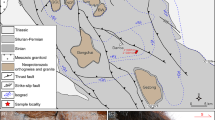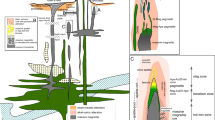Abstract
A mechanism for the solid state replacement of clinopyroxene by pyroxenoids has been derived from consideration of the crystal structures. The mechanism involves the propagation of partial dislocations, with Burgers vectors of 1/4\([2\bar 3\bar 1]\), through the clinopyroxene matrix to generate a resultant shear; the passage of one dislocation gives rise to a single chain-repeat unit of wollastonite in each silicate chain. Pyroxenoids may thus be formed from clinopyroxene by the periodic introduction of these dislocations on parallel slip-planes, and pyroxenoid to pyroxenoid inversions may proceed by the introduction and removal of such shears by the propagation of the correct combination of partial dislocations. The Burgers vectors for these dislocations in each of the pyroxenoid mineral structures has been calculated. A two step mechanism is proposed for clinopyroxene to bustamite, and pyroxenoid to bustamite inversions, which utilises the same shear as above which generates a wollastonite structure. The second step is a shear of 1/2[001] on the plane \((1\bar 10)\) of this wollastonite intermediate, to give a bustamite structure.
Similar content being viewed by others
References
Abrecht J (1980) Stability relations in the system CaSiO3-CaMnSi2O6-CaFeSi2O6. Contrib Mineral Petrol 74:253–260
Abrecht J, Peters Tj (1980) The miscibility gap between rhodonite and bustamite along the join MnSiO3-Ca0.6Mn0.4SiO3. Contrib Mineral Petrol 74:261–269
Aikawa N (1979) Oriented intergrowth of rhodonite and pyroxmangite and their transformation mechanism. Mineral J Japan 9:255–269
Akimoto S, Syono Y (1972) High pressure transformations in MnSiO3. Am Mineral 57:76–84
Buerger MJ, Prewitt CT (1961) The crystal structures of wollastonite and pectolite. Proc Nat Acad Sci 47:1884–1888
Burnham CW (1966) Ferrosilite III: A triclinic pyroxenoid polymorph of ferrous metasilicate. Science 154:513–516
Burnham CW (1971) The crystal structure of pyroxferroite from Mare Tranquillitatis. Proc 2nd Lunar Sci Conf 1:47–57
Czank M, Liebau F (1980) Periodicity faults in chain silicates: a new type of planar lattice fault observed with HREM. Phys Chem Minerals 6:85–93
Czank M, Simons B (1983) High resolution microscope studies on ferrosilite III. Phys Chem Minerals 9:229–234
Dent-Glasser LS, Glasser FP (1961) Silicate transformations: Rhodonite-wollastonite. Acta Crystallogr 14:818–822
Henmi C, Kawahara A, Henmi K, Kusachi I, Takeuchi Y (1983) The 3T, 4T, and 5T polytypes of wollastonite from Kushiro, Hiroshima Prefecture, Japan. Amer Mineral 68:156–163
Jefferson DA, Bown MG (1973) Polytypism and stacking disorder in wollastonite. Nature 245:43–44
Jefferson DA, Pugh NJ (1981) The ultrastructure of pyroxenoid chain silicates III: Intersecting defects in a synthetic iron-manganese pyroxenoid. Acta Crystallogr A37:281–286
Jefferson DA, Pugh NJ, Alario-Franco M, Mallinson LG, Millward GR, Thomas JM (1980) Ultrastructure of pyroxenoid chain silicates I: Variation of chain configuration in rhodonite. Acta Crystallogr A36:1058–1065
Koto K, Morimoto N, Narita H (1976) Crystallographic relationships of the pyroxenes and pyroxenoids. J Japan Assoc Mineral Petrol Econ Geol 71:248–254
Kronberg ML (1957) Plastic deformation of single crystals of sapphire: Basal slip and twinning. Acta Metall 5:507–524
Liebau F (1980) The role of cationic hydrogen in pyroxenoid crystal chemistry. Am Mineral 65:981–985
Morimoto N, Koto K, Shinohara T (1966) Oriented transformation of johannsenite to bustamite. Mineral J Japan 5:44–64
Murakami N, Takeuchi Y (1979) Structure of synthetic rhodonite, Mn0.685Mg0.315SiO3, and compositional transformations in pyroxenoids. Mineral J Japan 9:286–304
Narita H (1973) Crystal chemistry of pyroxene and pyroxenoid polymorphs of MnSiO3. Dr thesis, Osaka Univ, Osaka
Ohashi Y, Finger LW (1975) Pyroxenoids — a comparison of the refined structures of rhodonite and pyroxmangite. Carnegie Inst Washington Yearb 74:564–569
Ohashi Y, Finger LW (1976) Stepwise cation ordering in bustamite and disordering in wollastonite. Carnegie Inst Washington Yearb 75:746–754
Peacor DR, Niizeki N (1963) The redetermination and refinement of the crystal structure of rhodonite (Ca, Mn)SiO3. Z Kristallogr 119:98–116
Peacor DR, Prewitt CT (1963) Comparison of the crystal structures of bustamite and wollastonite. Am Mineral 48:588–596
Pinckney LR, Finger LW, Hazan RM, Burnham CW (1981) Crystal structure of pyroxmangite at high temperature. Carnegie Inst Washington Yearb 80:380–384
Poirier JP (1981) On the kinetics of the olivine-spinel transition. Phys Earth Planet Inter 26:179–187
Ried H, Korekawa M (1980) Transmission electron microscopy of synthetic and natural funferketten and siebenerketten pyroxenoids. Phys Chem Minerals 5:351–365
Schaller WT (1938) Johannsenite — a new manganese pyroxene. Am Mineral 23:575–582
Shannon RD, Prewitt CT (1969) Effective ionic radii in oxides and fluorides. Acta Crystallogr B25:925–946
Simons B, Woermann E (1982) Pyroxene-pyroxenoid transformations under high pressure. In: Schreyer W (ed) High Pressure Researches in Geoscience. E. Schweizerbart'sche Verlagbuchhandlung, Stuttgart, pp 529–536
Takeuchi Y, Koto K (1977) A systematics of pyroxenoid structures. Mineral J Japan 8:272–285
Veblen DR (1983) TEM study of a pyroxene-to-pyroxenoid reaction. Submitted to Am Mineral
Weber H-P (1983) Ferrosilite III, the high-temperature polymorph of FeSiO3. Acta Crystallogr C39:1–3
Wilkins RWT, Sverjensky DA (1977) The role of fluid inclusions in the exsolution of clinopyroxene in bustamite from Broken Hill, New South Wales, Australia. Am Mineral 62:465–474
Author information
Authors and Affiliations
Rights and permissions
About this article
Cite this article
Angel, R.J., Price, G.D. & Putnis, A. A mechanism for pyroxene-pyroxenoid and pyroxenoid-pyroxenoid transformations. Phys Chem Minerals 10, 236–243 (1984). https://doi.org/10.1007/BF00309316
Received:
Issue Date:
DOI: https://doi.org/10.1007/BF00309316




